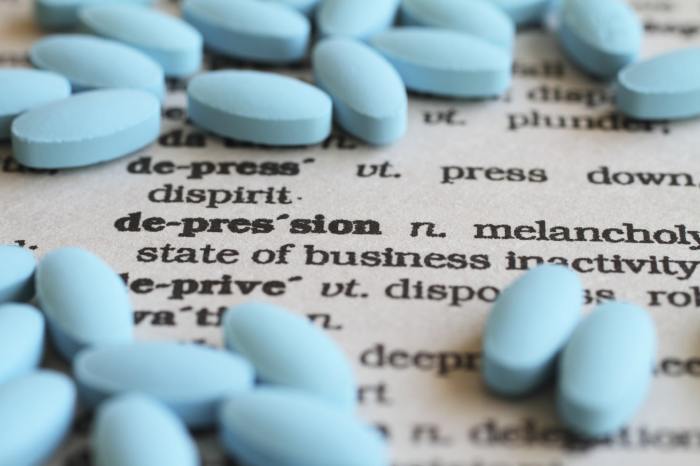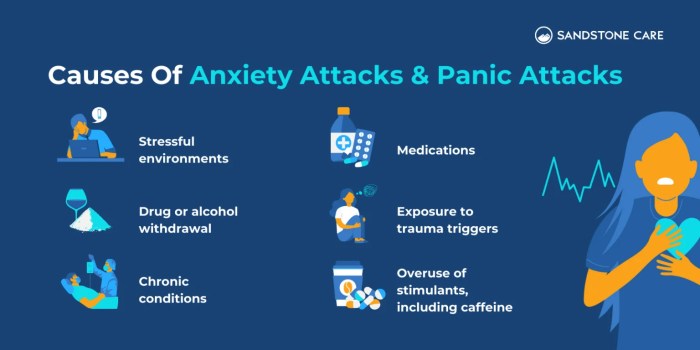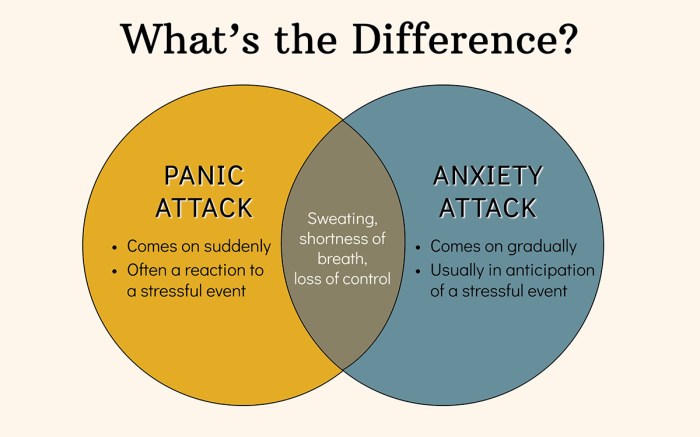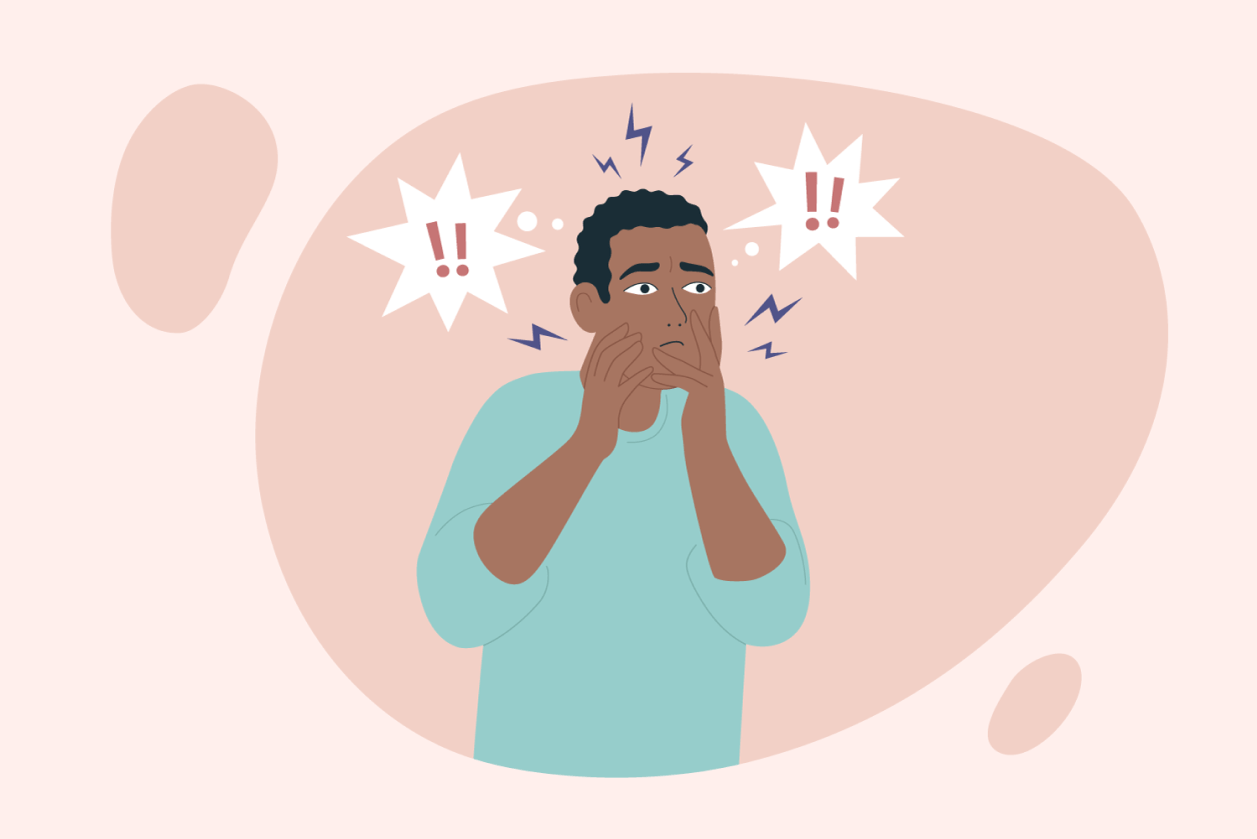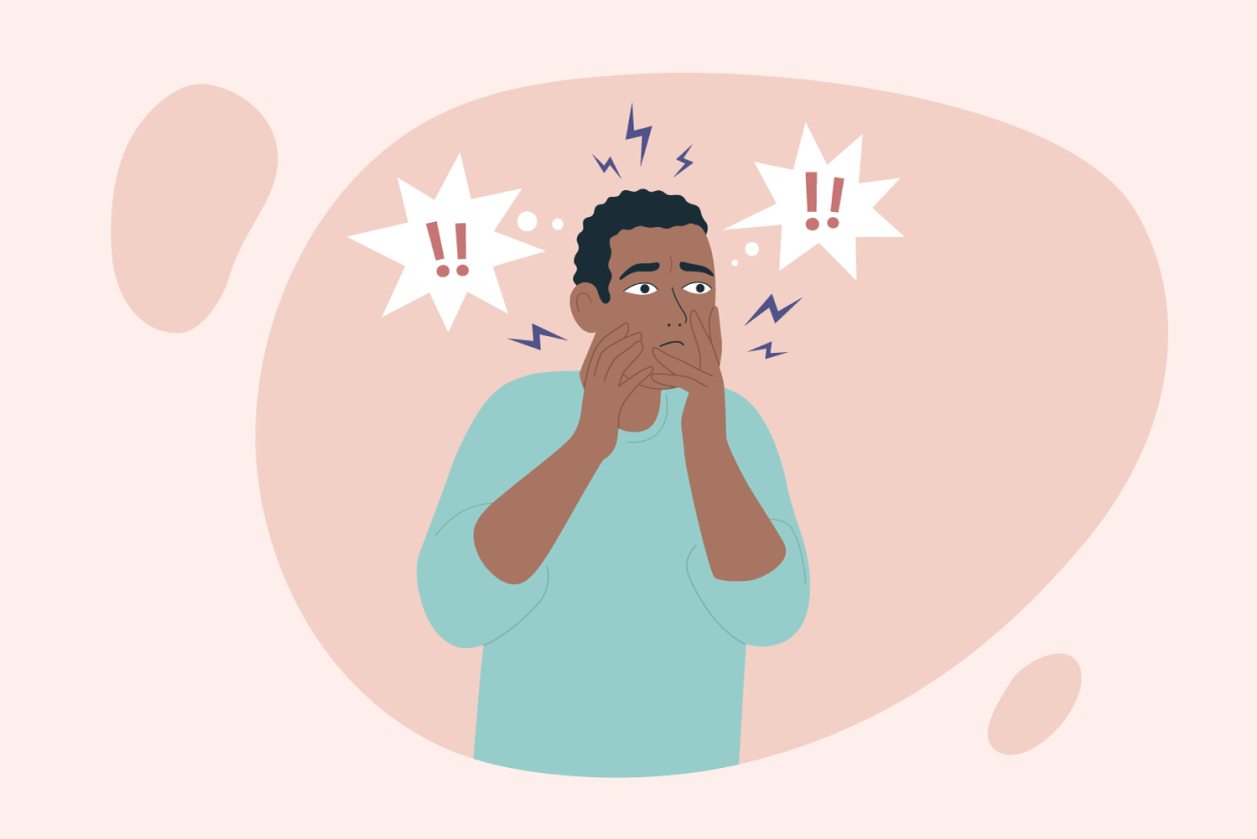How long do anxiety attacks last? This question plagues many experiencing these intense episodes. The answer isn’t straightforward, as attack duration varies significantly based on numerous factors. Understanding these factors, from the initial trigger to the role of individual responses, is key to navigating and managing anxiety.
This exploration delves into the multifaceted nature of anxiety attack duration, examining the interplay of internal and external influences. We’ll explore the defining characteristics of anxiety attacks, the diverse factors impacting their length, and practical strategies for coping with these episodes. The journey into understanding anxiety attack duration is one of self-awareness and empowerment.
Defining Anxiety Attacks
Anxiety attacks, also known as panic attacks, are sudden episodes of intense fear or discomfort that can feel overwhelming. They’re characterized by a rapid escalation of physical and psychological symptoms, often leaving the person feeling out of control and terrified. These episodes can be frightening and disruptive to daily life, impacting relationships, work, and overall well-being.Understanding the various facets of anxiety attacks is crucial for recognizing and managing them effectively.
The physiological responses, specific symptoms, and underlying anxiety disorders all contribute to the complexity of these experiences. Identifying the specific triggers and patterns can be valuable for developing coping mechanisms.
Symptoms of Anxiety Attacks
Anxiety attacks manifest in a range of physical and psychological symptoms. Recognizing these symptoms is crucial for timely intervention and management. Physical symptoms often include rapid heartbeat, shortness of breath, chest pain, sweating, trembling, and dizziness. Psychological symptoms can include feelings of intense fear, impending doom, losing control, or going crazy. The combination of these physical and psychological symptoms creates a highly distressing experience.
Physiological Responses During Anxiety Attacks
Anxiety attacks are characterized by a surge in the body’s fight-or-flight response. This physiological response is triggered by the release of stress hormones, like adrenaline and cortisol. These hormones prepare the body for immediate action, increasing heart rate, breathing rate, and blood pressure. This heightened state can manifest in various physical sensations, such as a pounding heart, shortness of breath, and sweating.
Types of Anxiety Disorders and Anxiety Attacks
Various anxiety disorders can contribute to the experience of anxiety attacks. Generalized anxiety disorder (GAD) is characterized by persistent and excessive worry about various aspects of life. Panic disorder is specifically defined by recurrent unexpected panic attacks. Social anxiety disorder is characterized by fear and avoidance of social situations. Phobias involve intense fear of specific objects or situations.
Post-traumatic stress disorder (PTSD) is a result of experiencing or witnessing a traumatic event. Each of these conditions can contribute to the occurrence of anxiety attacks, although the frequency and severity may vary depending on the individual and the specific disorder.
Comparison of Anxiety Attack Symptoms
| Symptom Category | Generalized Anxiety Disorder (GAD) | Panic Disorder | Social Anxiety Disorder | Phobias |
|---|---|---|---|---|
| Physical Symptoms | Muscle tension, fatigue, restlessness, headaches | Rapid heartbeat, shortness of breath, chest pain, sweating, trembling | Blushing, sweating, trembling, nausea, dizziness | Rapid heartbeat, shortness of breath, sweating, trembling, depending on the specific phobia |
| Psychological Symptoms | Excessive worry, apprehension, nervousness, difficulty concentrating | Fear of losing control, going crazy, dying, or impending doom | Fear of judgment, embarrassment, humiliation | Intense fear of the specific object or situation |
| Triggers | Everyday stressors, future events, responsibilities | Often unpredictable, sometimes triggered by specific situations | Social situations, public speaking, meeting new people | Specific object or situation |
This table provides a concise comparison of symptoms across different anxiety disorders. Note that individuals may experience varying combinations of symptoms and triggers.
Duration Factors
Anxiety attacks, while distressing, aren’t always prolonged events. Their duration varies significantly, influenced by several key factors. Understanding these elements can help individuals and those supporting them better navigate these episodes.The length of an anxiety attack is not a fixed timeframe. Instead, it’s a dynamic process, responsive to individual differences and the specific circumstances surrounding the attack. Severity, triggers, and coping mechanisms all play crucial roles in shaping the experience.
Severity of the Attack
Anxiety attacks can range from mild discomfort to intense, overwhelming panic. Milder episodes often resolve more quickly than severe ones. The intensity and physical sensations experienced during a peak moment directly correlate with the duration. A person experiencing a sudden, sharp spike in anxiety, perhaps due to a specific trigger, may find the episode shorter than someone experiencing prolonged and escalating anxiety over days or weeks.
Triggers and Individual Responses
Triggers, the specific factors that initiate an anxiety attack, play a substantial role in its duration. A sudden and unexpected trigger, like a loud noise or a fear-inducing event, can often result in a shorter, more intense attack. Conversely, a sustained trigger, such as chronic stress or relationship difficulties, can prolong the episode. Individual responses also differ; some individuals may quickly adapt to stressful situations and recover more swiftly, while others might require more time to manage their anxiety.
This personal resilience is a significant aspect in determining the length of the experience.
Stress and Coping Mechanisms
Stress, both acute and chronic, can exacerbate and prolong anxiety attacks. A stressful event, such as a job interview or a significant life change, can increase anxiety levels, potentially extending the duration of an attack. Effective coping mechanisms, such as deep breathing exercises, mindfulness techniques, or grounding exercises, can help individuals manage the intensity and shorten the duration of the attack.
The presence of supportive individuals or established coping strategies can significantly affect how quickly someone recovers from an anxiety attack.
Comparison Across Anxiety Disorders
The duration of anxiety attacks can vary across different anxiety disorders. Panic disorder, characterized by recurrent panic attacks, often involves more intense and potentially longer attacks compared to generalized anxiety disorder (GAD), where anxiety is more persistent but less intense. Specific phobias, triggered by a particular object or situation, typically result in shorter, more focused attacks, but those can still be highly distressing.
Social anxiety disorder may involve attacks that are triggered by social situations and can fluctuate in duration based on the individual’s perception of the social context.
Common Misconceptions
A common misconception is that anxiety attacks always last a specific amount of time. There’s no single, universally applicable duration. The experience is unique to each individual. Another common misconception is that the duration of the attack is a measure of its severity. While a more severe attack might be longer, duration isn’t the sole indicator of intensity.
Typical Duration Ranges for Different Anxiety Attack Triggers
| Trigger Category | Typical Duration Range (minutes) |
|---|---|
| Sudden, unexpected stressors (e.g., loud noise, fear-inducing event) | 5-20 |
| Sustained stressors (e.g., chronic stress, relationship difficulties) | 20-60+ |
| Specific phobias (e.g., fear of spiders, fear of heights) | 10-30 |
| Social anxiety triggers (e.g., public speaking, social interactions) | 15-45 |
Note: These are general guidelines and individual experiences may vary significantly.
Severity and Duration Correlation

Anxiety attacks, while often frightening, vary significantly in their intensity and duration. Understanding the connection between severity and duration is crucial for both self-management and professional intervention. This correlation isn’t a simple equation, however. A variety of factors play a role in shaping the experience, and recognizing these factors can empower individuals to better navigate and manage these episodes.
Severity and Physical Symptoms
The intensity of physical symptoms directly correlates with the potential duration of an anxiety attack. A more severe attack, characterized by intense physical sensations such as rapid heartbeat, shortness of breath, or chest pain, is more likely to last longer. This is because the body’s physiological response to fear and anxiety is amplified during these episodes. For example, someone experiencing a mild attack might notice a slight increase in heart rate and a feeling of unease, lasting for 10-20 minutes.
In contrast, a severe attack could involve pounding heart, dizziness, and a sense of impending doom, potentially lasting 30 minutes or more.
Psychological Factors
Psychological factors also significantly influence the duration of anxiety attacks. An individual’s perceived threat, their coping mechanisms, and their past experiences with anxiety all play a crucial role. If someone interprets a situation as highly threatening or has a history of prolonged anxiety, the attack might be more intense and drawn-out. For example, an individual confronting a feared social situation might experience a more prolonged anxiety attack, lasting longer than one triggered by a perceived minor threat.
Conversely, individuals with strong coping mechanisms might experience shorter, less intense attacks.
Professional Support’s Impact
Professional support, such as therapy or medication, can significantly impact the duration and severity of anxiety attacks. Cognitive Behavioral Therapy (CBT), for instance, equips individuals with tools to manage their thoughts and responses to anxiety-provoking situations. Medication, in some cases, can help regulate the physiological responses associated with anxiety attacks. This can result in shorter, less intense episodes, potentially even reducing the frequency of attacks over time.
For example, a patient undergoing CBT might learn to recognize and challenge their anxious thoughts, leading to quicker recovery from an attack.
Severity and Duration Table
| Severity Level | Typical Duration (minutes) | Physical Symptoms | Psychological Symptoms |
|---|---|---|---|
| Mild | 10-20 | Slight increase in heart rate, feeling of unease, light trembling | Feeling worried, apprehensive, difficulty concentrating |
| Moderate | 20-30 | Increased heart rate, shortness of breath, dizziness, sweating | Intense worry, fear of losing control, difficulty calming down |
| Severe | 30+ | Pounding heart, chest pain, difficulty breathing, nausea, trembling | Sense of impending doom, fear of death, panic |
Note: These are general guidelines. The actual duration of an anxiety attack can vary significantly from person to person.
External Factors Affecting Duration
Anxiety attacks aren’t isolated events; they’re often influenced by a complex interplay of internal and external factors. Understanding these external pressures can be crucial in managing the experience and developing coping strategies. Recognizing how environmental, social, and daily stressors affect the duration of an anxiety attack empowers individuals to proactively mitigate these triggers.Environmental factors, social interactions, and daily stressors all contribute to the duration and intensity of anxiety attacks.
By acknowledging these external influences, individuals can better prepare themselves to manage these challenging episodes.
Anxiety attacks can feel like they last forever, but thankfully, they usually don’t. While the intensity can feel overwhelming, the actual duration of an attack is typically shorter than you might think. Sometimes, coping mechanisms like stress-reduction techniques or even a strategy to delay your period can make a difference. How to delay your period can help manage stress around your cycle.
However, the exact length varies greatly from person to person, and the best approach is to talk to a doctor for personalized guidance and support. Understanding how long an attack lasts is key to managing the overall experience.
Environmental Factors
Environmental factors play a significant role in the duration of anxiety attacks. Changes in surroundings, be it a loud, crowded space or a quiet, unfamiliar environment, can trigger or exacerbate anxiety responses. A sudden change in temperature, light, or even smell can be a trigger. The environment acts as a potent reminder of experiences associated with past traumas, and these associations can easily activate anxiety responses.
For example, a person who experienced a panic attack in a particular store might find that even the mere presence of that store’s exterior triggers similar feelings.
Social Situations and Interactions
Social interactions can significantly impact the duration of an anxiety attack. Social situations that demand public speaking, performing, or navigating complex social dynamics can increase the risk and duration of anxiety attacks. The pressure to present a certain image, to maintain composure, or to perform well can be incredibly stressful. For instance, a job interview, a first date, or a presentation to a large audience can be highly anxiety-provoking.
A person’s perception of social situations can be a critical factor in the length and intensity of the attack.
Daily Stressors
Daily stressors, both large and small, can influence the duration of anxiety attacks. These stressors can include work deadlines, financial worries, relationship conflicts, or even seemingly minor inconveniences. Accumulated stress over time can increase susceptibility to anxiety attacks. For example, someone consistently juggling multiple demanding projects at work may find that even minor setbacks trigger a prolonged anxiety response.
Support Network Impact
The presence and nature of a person’s support network can significantly influence the duration of an anxiety attack. A strong support network provides comfort, understanding, and practical assistance during challenging times. This could include a close friend, family member, or therapist who can offer reassurance and practical coping mechanisms. Conversely, a lack of social support can prolong and intensify the experience.
A person who feels isolated or unsupported might find it more difficult to manage the symptoms of an attack.
Table: External Factors and Potential Impact on Attack Duration
| External Factor | Potential Impact on Attack Duration |
|---|---|
| Loud, crowded environments | Can trigger or exacerbate anxiety, potentially leading to a longer attack. |
| Unfamiliar or threatening environments | Can heighten anxiety, increasing attack duration. |
| Social interactions (demanding situations) | Increased pressure to perform can lead to longer and more intense attacks. |
| Daily stressors (accumulated) | Increased susceptibility and potential for longer duration attacks. |
| Lack of social support | Can prolong and intensify anxiety attacks. |
Intervention Strategies and Duration
Anxiety attacks, while distressing, are manageable. Understanding effective intervention strategies is crucial for shortening their duration and improving overall well-being. These strategies, combined with professional support, can significantly impact the experience and recovery time from an attack.Effective intervention strategies can empower individuals to regain control during an anxiety attack and potentially shorten its duration. By learning and practicing these techniques, individuals can develop coping mechanisms that reduce the intensity and duration of future episodes.
This proactive approach contributes to a greater sense of agency and control over their well-being.
Relaxation Techniques for Managing Anxiety Attacks
Relaxation techniques are fundamental tools for managing anxiety attacks. These methods aim to calm the body and mind, counteracting the physiological responses associated with anxiety. Deep breathing exercises, progressive muscle relaxation, and guided imagery are examples of highly effective relaxation strategies. By focusing on physical sensations and mental imagery, these techniques can help individuals shift their focus away from anxious thoughts and feelings.
Breathing Exercises for Shortening Attack Duration
Breathing exercises are a cornerstone of anxiety management. Controlled breathing can directly influence the body’s physiological response to stress. Techniques like box breathing, alternate nostril breathing, and diaphragmatic breathing are particularly helpful in calming the nervous system. Consistent practice can help individuals learn to regulate their breathing patterns, reducing the duration and intensity of anxiety attacks. For instance, box breathing involves inhaling for a count of four, holding for four, exhaling for four, and holding for four, creating a rhythmic pattern that promotes relaxation.
Mindfulness Practices and Anxiety Attack Duration
Mindfulness practices encourage individuals to be present in the moment without judgment. By focusing on the sensations, thoughts, and emotions in the present, mindfulness can help individuals detach from anxious thoughts and feelings. Mindfulness exercises like body scans, meditation, and mindful walking can cultivate a greater sense of awareness and emotional regulation. Mindful attention to the present moment can help individuals observe their anxious thoughts and feelings without getting caught up in them.
This detachment can potentially shorten the duration of an anxiety attack.
Therapy’s Impact on Anxiety Attack Length
Therapy plays a pivotal role in addressing the underlying causes of anxiety and developing coping strategies. Cognitive Behavioral Therapy (CBT), for example, helps individuals identify and modify negative thought patterns that contribute to anxiety. Exposure therapy, another effective method, gradually exposes individuals to feared situations, enabling them to build resilience and reduce the anxiety response over time. The impact of therapy on anxiety attack duration is significant, as it empowers individuals to understand and manage their anxiety effectively.
Comparison of Intervention Methods
Different intervention methods offer varying approaches to managing anxiety attacks. While relaxation techniques focus on immediate calming, therapies like CBT delve into the root causes of anxiety. Mindfulness practices cultivate present-moment awareness, which can help individuals detach from anxious thoughts. Each method offers a unique avenue for managing anxiety and potentially reducing the duration of attacks. The choice of intervention often depends on the individual’s specific needs and preferences.
Intervention Methods and Potential Effects on Attack Duration
| Intervention Method | Potential Effect on Attack Duration | Explanation |
|---|---|---|
| Relaxation Techniques (e.g., deep breathing) | Potentially shorter duration | Reduces physiological responses, promoting calmness. |
| Breathing Exercises (e.g., box breathing) | Potentially shorter duration | Regulates the nervous system, reducing anxiety symptoms. |
| Mindfulness Practices (e.g., meditation) | Potentially shorter duration | Cultivates present-moment awareness, reducing detachment from anxious thoughts. |
| Cognitive Behavioral Therapy (CBT) | Significant reduction in duration and frequency | Addresses underlying causes of anxiety, teaching coping strategies. |
| Exposure Therapy | Potentially shorter duration and reduced severity | Gradually exposes individuals to feared situations, building resilience. |
Duration Variations and Individual Differences
Anxiety attacks, while often perceived as a singular experience, manifest in a wide spectrum of durations, varying significantly from person to person. This variability stems from a complex interplay of personal experiences, pre-existing conditions, cultural influences, and even genetic predispositions. Understanding these factors is crucial for developing effective coping mechanisms and interventions tailored to individual needs.The duration of an anxiety attack isn’t a fixed timeframe; it can fluctuate dramatically.
Some individuals experience brief, intense episodes, while others endure prolonged periods of distress. This difference highlights the importance of recognizing individual experiences and tailoring support strategies accordingly. Recognizing these variations is crucial for appropriate intervention and effective management.
Personal Experiences and Pre-existing Conditions
Personal experiences, including past traumas, stressful life events, and significant relationship challenges, can profoundly influence the duration of anxiety attacks. Individuals with pre-existing conditions, such as depression or other mental health disorders, may also experience attacks of varying lengths, influenced by the severity and nature of the underlying condition. The cumulative impact of these factors can contribute to longer-lasting episodes.
For example, someone who has experienced significant childhood trauma might experience more prolonged anxiety attacks than someone who hasn’t.
Anxiety attacks can feel like a whirlwind, lasting anywhere from a few minutes to a half hour or more. It’s really all about how your body and mind react. Interestingly, a recent study on zepbound keeps weight off 3 years suggests that managing stress and weight can positively impact overall well-being, which might indirectly influence how long an attack lasts.
Ultimately, though, the duration varies greatly from person to person, and seeking professional help is key for understanding and managing anxiety.
Cultural Factors Affecting Perception and Duration
Cultural factors significantly shape the perception and experience of anxiety attacks. Cultural norms regarding emotional expression, acceptable coping mechanisms, and the stigma surrounding mental health conditions can influence how individuals perceive and describe their experiences. For example, in some cultures, expressing anxiety outwardly might be discouraged, leading individuals to internalize their distress and potentially prolong the duration of the attack.
Cultural variations in help-seeking behaviors can also play a role.
Anxiety attacks can feel like they last forever, but thankfully, they’re usually shorter than you think. While the intensity is often overwhelming, the actual duration varies greatly depending on the individual and the severity of the attack. Understanding different types of anxiety disorders, including those potentially linked to narcissistic personality disorder types , can help pinpoint potential triggers and factors that influence the duration of these episodes.
Ultimately, knowing how long they typically last can help you feel more prepared and in control during a difficult moment.
Genetic Predispositions and Duration Variations
Genetic predispositions may play a role in the duration of anxiety attacks. Research suggests a link between specific genes and the likelihood of developing anxiety disorders and the intensity and duration of symptoms. This genetic influence, combined with environmental factors, can contribute to the wide range of durations observed among individuals. For instance, a family history of anxiety disorders could indicate a higher risk for longer-lasting attacks.
Table Comparing Duration of Anxiety Attacks Across Demographics
| Demographic Group | Typical Duration Range (minutes) | Potential Factors |
|---|---|---|
| Individuals with a history of trauma | 20-60+ | Past experiences, heightened sensitivity, potential for re-experiencing trauma |
| Individuals with pre-existing depression | 15-45+ | Underlying depressive symptoms, potential for comorbidity |
| Individuals from cultures that discourage emotional expression | 15-30+ | Internalization of distress, limited opportunities for coping |
| Individuals with a family history of anxiety | 10-50+ | Genetic predisposition, potential for more intense reactions |
Note: This table provides generalized ranges and should not be considered a definitive guide. Individual experiences vary significantly. The listed factors are not exhaustive.
Seeking Professional Help and Duration: How Long Do Anxiety Attacks Last

Anxiety attacks can be incredibly distressing, impacting daily life and well-being. Understanding the potential for professional help to influence the duration and frequency of these episodes is crucial for effective management. Seeking guidance from a mental health professional can provide a roadmap for coping and recovery.Professional help isn’t just about managing symptoms; it’s about understanding the root causes of anxiety and developing strategies to prevent future attacks.
Early intervention is often key to reducing the overall duration and severity of anxiety attacks.
Importance of Early Intervention
Early intervention in anxiety disorders can significantly impact the duration and frequency of future attacks. By addressing the underlying issues and developing coping mechanisms early on, individuals can potentially reduce the intensity and duration of future episodes. This early engagement can also prevent the development of chronic anxiety disorders and their associated long-term impacts. A prompt response to anxiety symptoms can lead to a more manageable and less disruptive experience over time.
Role of Therapy in Reducing Anxiety Attacks
Therapy plays a vital role in managing anxiety attacks. Cognitive Behavioral Therapy (CBT) is a highly effective form of therapy for anxiety. It helps individuals identify and challenge negative thought patterns that contribute to anxiety, and develop healthier coping mechanisms. Through techniques like exposure therapy and relaxation training, therapy empowers individuals to confront anxiety-provoking situations and manage their physiological responses more effectively, thus potentially reducing the duration of attacks.
Furthermore, therapy can teach individuals strategies to recognize and manage early warning signs of an anxiety attack, allowing them to intervene before the attack escalates.
Impact of Medications on Attack Duration
Medications can play a significant role in reducing the duration of anxiety attacks. Certain medications, like antidepressants and anti-anxiety drugs, can help regulate neurochemicals in the brain that contribute to anxiety. Anti-anxiety medications, while effective in reducing the immediate symptoms of an attack, often need to be combined with therapy for long-term management. While medications can help shorten the duration of individual attacks, they don’t address the underlying causes of anxiety.
Therefore, medication should be used as part of a comprehensive treatment plan that also includes therapy and lifestyle adjustments.
Comparison of Professional Help
| Type of Professional Help | Potential Impact on Attack Duration | Further Considerations |
|---|---|---|
| Cognitive Behavioral Therapy (CBT) | Potentially reduces the duration and frequency of attacks by addressing underlying thought patterns and behaviors. | CBT often requires ongoing commitment and effort. |
| Medication (e.g., antidepressants, anti-anxiety drugs) | Can reduce the duration of individual attacks by regulating neurochemicals. | Medications may have side effects and should be used under medical supervision. |
| Mindfulness-Based Stress Reduction (MBSR) | Can reduce anxiety symptoms by promoting present moment awareness and relaxation techniques. | MBSR can be beneficial as a complementary therapy. |
| Exposure Therapy | Gradually exposes individuals to feared situations, helping them to build coping mechanisms and reducing anxiety. | Exposure therapy can be challenging and may require significant time and commitment. |
| Support Groups | Provides a supportive environment for individuals to share experiences and coping strategies. | Support groups can be helpful in managing the social aspects of anxiety. |
Illustrative Case Studies
Understanding anxiety attacks requires more than just knowing the average duration. Real-life examples illuminate the complexities of these experiences and the impact of various factors on their course. These cases highlight how different individuals respond to anxiety attacks and the wide range of possible durations.
Case Study 1: Sarah’s Experience
“Sarah, a 28-year-old marketing professional, frequently experienced intense anxiety attacks characterized by rapid heartbeat, shortness of breath, and overwhelming fear. Her attacks typically lasted between 15 and 30 minutes, often triggered by public speaking engagements. Cognitive behavioral therapy (CBT) and mindfulness exercises were crucial in helping her manage the frequency and duration of these episodes. With consistent therapy, Sarah noticed a significant reduction in the duration of her attacks, often bringing them down to 5-10 minutes.”
This case exemplifies how anxiety attacks can be triggered by specific situations and how therapy can play a vital role in reducing their duration. The interplay between the situational trigger and the subsequent psychological response is crucial.
Case Study 2: David’s Journey
“David, a 35-year-old software engineer, experienced panic attacks that manifested as a terrifying sense of impending doom. His attacks were often protracted, lasting from 45 minutes to over an hour. These attacks were significantly impacted by his high-pressure job and a recent family conflict. Exposure therapy, combined with medication, proved to be the most effective intervention, allowing David to progressively manage the duration and intensity of his episodes.”
This case underscores the importance of considering external stressors and how they can influence the duration and severity of anxiety attacks. It also illustrates the effectiveness of a multifaceted treatment approach combining therapy and medication.
Case Study 3: Emily’s Coping Mechanism, How long do anxiety attacks last
“Emily, a 22-year-old student, experienced anticipatory anxiety before exams. Her anxiety attacks, triggered by the impending exam, would often last for several hours, manifesting in physical symptoms and feelings of helplessness. Learning relaxation techniques and developing a structured study plan helped her significantly reduce the duration of these attacks, bringing them down to 15-30 minutes, allowing her to focus on the tasks at hand.”
This case demonstrates how anticipatory anxiety can significantly prolong the duration of anxiety attacks and the role of a proactive approach to managing the trigger can significantly improve the experience. It emphasizes the importance of self-care and coping strategies in reducing the impact of such attacks.
End of Discussion
In conclusion, the duration of an anxiety attack is a complex interplay of individual factors, triggers, and coping mechanisms. Understanding the range of influences on duration—from severity and stress levels to environmental factors and personal support—is crucial for effective management. Seeking professional help is vital, and incorporating coping strategies can significantly impact the duration and frequency of future attacks.
Ultimately, the journey to understanding and managing anxiety attack duration is a personalized one, requiring self-awareness and a proactive approach to well-being.












